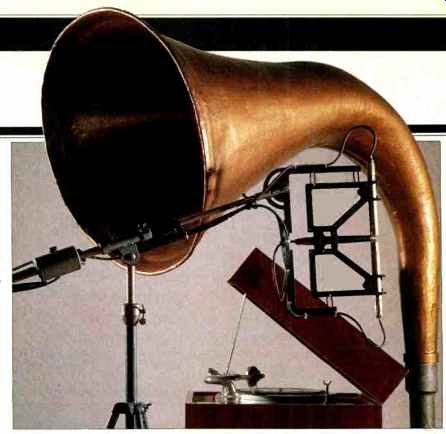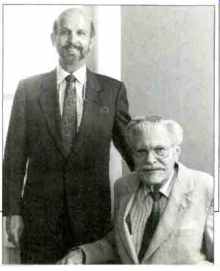REDIRECT

above: The microphone system and player used in Nimbus' Natural Ambisonic Transfer system.
Direct to Disc-and from It
From the '50s on, most recordings have been made on tape and transferred to disc. Before then, all recordings were made direct to disc (or, still earlier, to cylinder). In the '70s, some audiophile labels began recording directly onto disc again, to regain the edge of clarity lost by the intermediary stage of analog tape.
Now Reference Recordings has made a record direct to CD--and Nimbus has a series of recordings made direct from disc.
In the case of Nimbus' Prima Voce series, the discs are 78-rpm collectors' items, made by such operatic artists as Luisa Tetrazzini, Lawrence Tibbett, Conchita Supervia, Beniamino Gigli, Amelita Galli-Curci, Claudia Muzio, Lotte Lehmann, Giovanni Martinelli, Rosa Ponselle, and the inevitable Enrico Caruso.
Transferring historic recordings like these to CD is nothing new, but Nimbus' Natural Ambisonic Transfer system is. Instead of playing the disc with a modern cartridge, Nimbus used an acoustic gramophone pickup, complete with thorn needle and brass horn, attached to a modern turntable (more accurate in speed and more convenient than the windup original). This setup was placed in Nimbus' small concert hall and recorded with an Ambisonic microphone.
According to Nimbus, this system naturally filters out the hisses, crackles, and pops normally heard when old discs are played on modern phonographs. "What emerges has the power to make old things new and, still more vital, to bring the old out into the light of day where it may be appreciated by the young," wrote John Steane, in Gramophone, of the discs' introduction.
If Nimbus' process is surprisingly direct, the process used to make Reference Recordings' first direct CD was fairly roundabout. First, Dick Hyman played music by Fats Waller on a Bosendorfer SE computerized reproducing piano in New York. The piano recorded his keystrokes and expression onto a floppy disk, which was then used to re-create his performance on another SE in a California studio. The signal picked up by the studio's microphones was then converted to a digital bit stream and transmitted by microwave to the CD mastering facility at Disctronics Manufacturing, where it was then put on disc.
Producer J. Tamblyn Henderson says, "Most manufacturers of Compact Discs will admit that their finished product does not sound the same as the original master. In this case, the finished product is identical to the master."
Dick Hyman Plays Fats Waller (RR-33DCD) was engineered by Keith O. Johnson, and the mastering was supervised by Robert Harley. It will initially be issued in a deluxe limited edition for $30, after which it will come out on regular CDs, LPs, and cassettes.
-------------------
dBmystery
The dBm is an old familiar electrical unit that stands for decibels referred to 1 milliwatt. For a 600-ohm line, this would be equivalent to 0.775 V. But there seems to be a new unit, with the same abbreviation, used for optical connections on CD players. It cropped up in the specifications for Sony's CDP-X7ESD and Philips' LHH1000, reviewed in the November 1989 and January 1990 issues.
What's dBm stand for? Search me--we've yet to find anyone at Sony or Philips who can explain it!
Spinning, but Not in Their Graves
The turntable is dead, right? Wrong.
According to Kevin Byrne of Ortofon, figures from the Electronics Industries Association show that more than 180,000 turntables were sold by major companies in the first five months of 1989. That's nearly 50% more than the total of all preamps, power amps, integrated amps, and tuners these companies sold in that period. Sales of CD players during those same months, however, totaled about 1,205,000. The turntable is still spinning, but CD is winning.
Moving to a New Ohm
The volt and the ohm are not what they used to be. As of January 1, 1990, the National Institute of Standards and Technology established new values for them (based on new, state-of-the-art measurement techniques) to bring them in line with international standards. As a result, the standard volt will increase by about 9.26 parts per million, and the standard ohm by about 1.69 ppm. These small changes won't affect audio measurements or specs.
Arkansas Tweaker Steps Down, Keeps Fiddling

One of audio's grand old lions, Paul W. Klipsch, has sold his speaker firm, Klipsch & Associates, to his cousin, businessman Fred S. Klipsch of Indianapolis. Founded in 1946 and based in Hope, Arkansas, Klipsch & Associates builds speakers for home, professional, and theater use. Fred Klipsch replaces his cousin as chairman of the board; 85-year-old Paul remains as a technical and marketing adviser.
The elder Klipsch, long known as a free-spoken audio maverick, has been known to circulate buttons at audio conventions emblazoned with his favorite eight-letter expletive. Fond of collecting quotes, he expressed his feelings about his new job at Klipsch & Associates by referring to Leslie Ayre's The Wit of Music: "When in his 80s, Pierre Monteux signed a 25 year contract as principal conductor of the London Symphony Orchestra, on the strict condition that he could have an option for another 25 years." Two (perhaps contrasting) sayings Klipsch also likes to repeat are Dr. Irving Gardner's "You can't make what you can't measure because you don't know when you've got it made" and this, from L. L. Beranek's book, Acoustics: "If one selects his own components, builds his own enclosure, and is convinced he has made a wise choice of design, then his own loudspeaker sounds better to him than anyone else's loudspeaker.
In this case, the frequency response of the loudspeaker seems only to play a minor part in forming a person's opinion."
-Tony Scherman
Koss and Effect
Promotional T-shirts usually show just company logos, plus an occasional product or two. Koss' are a bit more creative. The most straightforward of their shirts, adorned with "Support Your Right to Privacy," shows a headphone wearing listener next to a non-listener.
Another shirt shows a slightly glum, James Deanish figure labeled "Rebel Without A Koss"; the back of the shirt shows the same figure, wearing headphones and smiling "Rebel With A Koss," naturally. And then, of course, there's the quasi-cubist headphone wearer by "Pikosso," modeled above.
Coda: Deane E. Jensen
Deane Ellsworth Jensen passed away suddenly in the North Hollywood laboratory of Jensen Transformers, on the weekend of October 21, 1989. Though he was only 47 at his death, Jensen had already become well known as a designer and manufacturer of low distortion audio transformers. He also developed the COMTRAN circuit analysis program for use in computer aided design and had published many articles on high-frequency phase response and its audible effects. Born in Annapolis, Maryland in 1942, Jensen attended the University of Pennsylvania, where he worked with WXPN, the student operated radio station. He founded Jensen Transformers in 1972. His family requests that any memorial contributions be sent to the Richard C. Heyser Memorial Scholarship Fund, in care of the Audio Engineering Society, 60 East 42nd St., New York, N.Y. 10165.
Quibbles and Bits
Brace yourself for a semantic squall over the term "oversampling." In playback of digital recordings, as all agree, it means using a higher sampling rate than that of the original recording. This is done so that the sampling frequency can be removed from the output more by digital than by analog filters.
In recording, the same idea can be applied to the anti-aliasing filter used at the input to an A/D converter. These filters prevent aliasing distortion by removing from the input signal all frequencies higher than the Nyquist limit (half the sampling rate). An oversampling input filter uses a much higher sampling rate than that of the eventual recording, so little or no analog filtration is required. At the 128-times oversampling rate now used by Chesky Records, for example, the audio input need only be cut off above 2.8224 MHz, where there's probably no signal anyway.
After that, all frequencies above 20 or 22 kHz (the Nyquist limit for Compact Discs) can be filtered out in the digital domain, with no phase problems or other filter side effects.
Another way around the antialiasing filter problem is to actually record at higher sampling rates-and I'm told that professional decks with 88.2-MHz recording are in the offing.
Some recording engineers feel that the term "oversampling" should be reserved for such machines.
Until this gets wrangled into a consensus, it will pay to be specific when we use the term. I favor applying it to input or output filters, or to NC) or D/A converters. As to recording at a higher rate, let's call it just that-as we do already when we talk about DAT recording at 44.1 or 43 kHz.
(adapted from Audio magazine, Feb. 1990)
= = = =